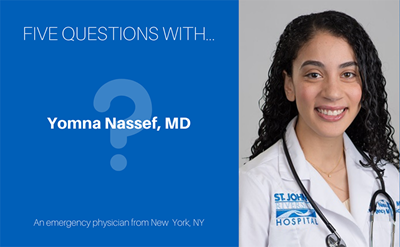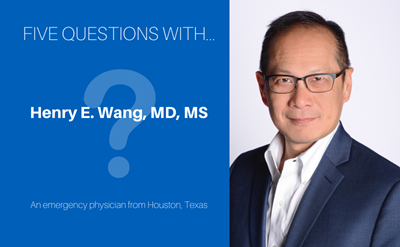A great deal has been written about physician burnout, especially in Emergency Medicine. Inefficient electronic medical records, rapidly decreasing resources, increasing job demands, litigation risks, huge debt burdens from training, and on and on. But in my opinion, much of this is common to any career. Show me a person that doesn’t ask themselves at least once, no matter what their occupation, “Why am I still here?”, and I’ll show you someone too exhausted from work to even ask introspective questions. Well, for me, crushing student loan debt is a huge motivator, but to be truthful I did make a kind of commitment to society to be here as a doctor when I got accepted to medical school. So I figure I’ll stick it out. Plus, to be honest, even with all our grousing . . . it is kind of cool.
It was one of my first shifts at a small hospital, the kind of place where the ER doc is pretty much it—no backup, no help, just you and a couple nurses, and maybe a tech. We were a bit short-staffed this day because of a heavy snow, but at least we weren’t terribly busy.
“Suicide Is Painless,” known to the world as the theme song to M*A*S*H, emanated from the medic control radio, letting us know we had an incoming call from an ambulance. I always thought it was strangely ironic every time I heard those tones.
Paramedics were bringing in a man in his late 70s who was in cardiac arrest. His heart wasn’t beating, he wasn’t breathing. In any other profession he’d just be called dead. We say cardiac arrest. It sounds more temporary.
The medics were doing CPR and giving all of the drugs they were supposed to, but as they spoke, it became obvious that things weren’t going well. We got all our gear together to take over his care—maybe we could use some of our ER skills and magic to jumpstart him back into existence.
The EMS crew arrived in a typical organized chaos of activity, disconnecting and reconnecting monitors and lines, shouting out the report, squeezing more drugs into the IV bag, reconnecting defibrillator pads, connecting all the plugs, moving the soon-to-be body over to our cart, all while continuing to pound on the chest in an uninterrupted, almost lyrical, cadence of one and two, and one and two, and . . .
I caught sight of her amidst all the activity. She was being led in by a firefighter, slowly, his arm gently supporting hers, as if they were walking into church; an elegant-looking woman, hair done just so, finely pressed sweater and slacks, looking like page 10 of a bygone Junior League Cookbook. The tears rolling down her cheeks seemed out of place on her, like the face of a woman that never knew true sadness or true fear.
It was kind of “game on” for us at that point. I did all the things an ER doc does, and the nurses tried every trick they knew. We pushed all the drugs in all the right ways, just like the protocols tell you—some epi here, some amio there, a bit of bicarb, a jolt of electricity when needed, check for a pulse, maybe some more chest compressions, things like that . . . All the while she sat there holding her husband’s hand, feeling the last of his warmth go into her fingers. They had been married for fifty-seven years she told us above the beeps of machines. He was a wonderful husband and father, and you could feel her love for him in every word she spoke. Her words had substance and mass, like you could put them on the shelf for all to see.
She begged him not to go out and shovel snow that morning, but he insisted it was “his job” to take care of her. He died trying to keep her path clear and safe.
I announced as gently as I could, but out-loud for all (including her) to hear, that we would stop after the next round of CPR, and I asked, as many ER docs do, if the team had any ideas we hadn’t tried yet or had any objections to stopping. No one could think of anything we hadn’t already tried.
As with the end of every code, I said, “Okay, we’ll stop after the next pulse check.” This time, for whatever reason, the words kept sticking in my throat—as if her words of endearment had jumped off the shelf and lodged deep in my voice box, as if to beg, “Just a few more seconds. Please.”
We finally stopped—there was nothing more we could do and took our moment of silence for him. Many ERs do this before declaring a time of death. It allows us to remember we are transitioning from caring for a living person to tending a memory of a life once lived. This was somebody she loved, this was a person. The weight of that is never lost on us.
There was something about her, the hand-holding, the weighted words, the tears of loss that brought out open sobs and several hugs of empathy from the nurses . . . and a few from me.
Can something tear at you and also be fulfilling? Absolutely. I’m often humbled by the enormity of what the ER team does. It is an intimate privilege to be with a person at the time of their passing and to at least offer comfort when you have nothing else to offer. I called a stop to our efforts and looked at the clock to mark the time of death.
I’d been in the room for nearly an hour, but it seemed like only a few minutes. Time’s funny that way . . . but the world keeps moving and patients keep coming.
The registration staff told me that, thankfully, only one patient had checked in during the last hour. I was still shaken a bit from the drama and emotion of the last hour, knowing someone’s husband, someone’s father, someone’s son now lay still under the blanket just a few doors down. But as I approached the next patient’s room, I was met with the sounds of laughter coming from behind the door. An infant “having trouble breathing” according to the chart . . .
In the room, sitting on the bed, was a young couple, holding a smiling, happy, beautiful little baby girl in a pink jumper, her nose running just a bit, who was laughing at the silly faces her parents were making at her. In the corner of the room stood what was almost certainly two sets of not-so-concerned grandparents who flashed me that “yeah, they are first-time parents” kind of knowing smile.
“She’s fine, we don’t really need you anymore” came the unexpected reply to my introduction. The young couple explained that they were staying in a hotel while visiting their families. The baby had a runny nose for a couple days and they noticed her breathing became a bit noisy when she napped. They got nervous, perhaps jumped the gun, and brought her to the hospital.
Naturally both sets of grandparents were called and they rushed in too. More experienced heads—those who grew up in a time of chickenpox and a world without hand sanitizer—performed their own examination, noting with an eye of Asclepius, that she had no fever, was smiling and cooing, still taking readily to the breast, making wet diapers, and looked, well, like a child that pretty much didn’t need to be seen by me. I suspect one of them even peeked in her ears with the otoscope, because it was half hanging out of its holder. They had decided, correctly I might add, that she was okay and just had a runny nose.
“So,” I asked as I replaced the otoscope into its base, “if you know she is okay, why did you guys stay?” Their answer solidified this child’s place in my heart, and deep in my soul, as perhaps my favorite patient ever.
“We heard what was happening in the other room and figured you and the nurses could use a happy baby break. So check her out, Doc, make sure that her grandmas are right, that she’s okay.” They smiled.
It’s really hard to do a decent physical exam when you can’t see through tears you are trying unsuccessfully to hold back, and I’m not sure how the nurses documented their bouncing a laughing baby on their knees (there isn’t much diagnostic relevance in that), but there is simply no sound better for a heavy heart to hear than a laughing baby.
So why do I stay?
Well . . . simply put: being an ER doc is magical.
That and the crushing student debt thing.
 American College of Emergency Physicians
American College of Emergency Physicians







